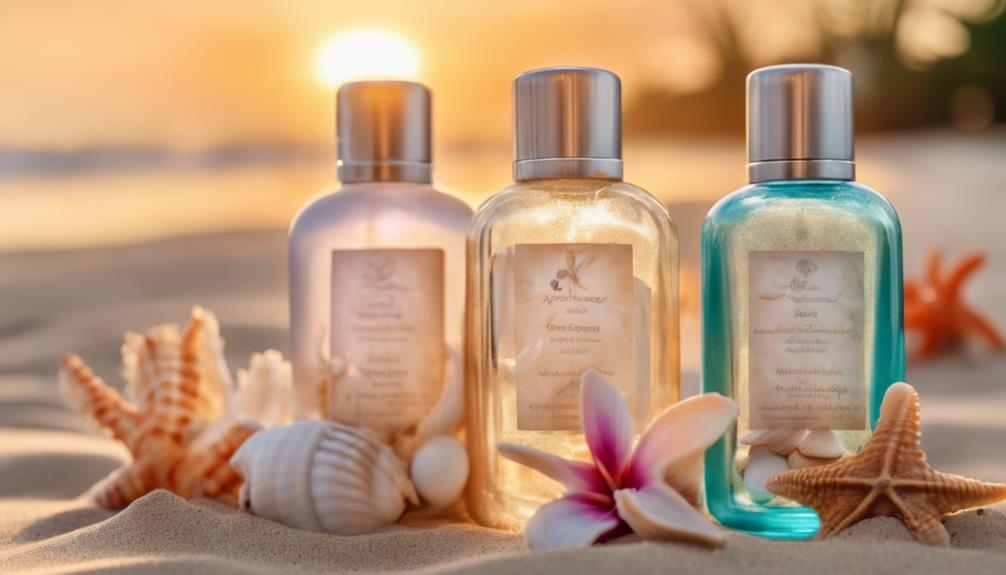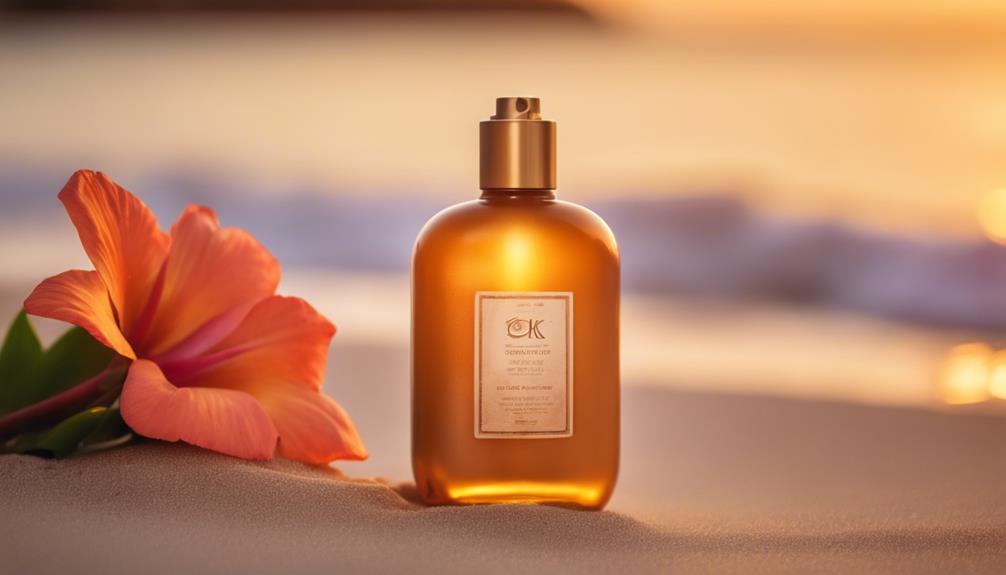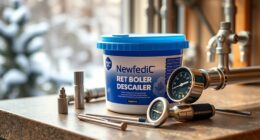To discover your perfect after-tan lotion, start by looking for tan extenders that hydrate and nourish your skin. Ingredients like aloe vera, shea butter, and coconut oil are great for soothing and retaining moisture. Apply your lotion immediately after tanning for best results, focusing on dry areas. If you have sensitive skin, choose hypoallergenic options to minimize irritation. The right fragrance can enhance your tan experience, but don't hesitate to opt for fragrance-free if you're prone to reactions. Ready to keep that glowing skin vibrant and healthy? Keep exploring to uncover more about your choices!
Key Takeaways
- Look for tan extenders with hydrating ingredients like aloe vera and shea butter to enhance and prolong your tan.
- Choose hypoallergenic options if you have sensitive skin to minimize irritation and ensure comfort.
- Consider your fragrance preference; select subtle scents or fragrance-free options to suit your sensitivity levels.
- Apply your chosen lotion immediately after tanning to maximize absorption and maintain an even glow.
Benefits of Tan Extenders
Using tan extenders can greatly enhance your tanning results by providing long-lasting hydration and extending the life of your tan.
These products nourish your skin with essential vitamins and antioxidants, ensuring it stays healthy and radiant.
By minimizing unevenness and blotchiness, tan extenders help maintain a smooth, even glow.
They soothe and heal sun-exposed skin, making them perfect for post-tanning care.
Additionally, the deep hydration they offer helps retain bronzing pigments longer, reducing the risk of peeling.
With improved overall skin texture and appearance, you'll not only enjoy your tan more but also feel confident in your skin.
Incorporating a tan extender into your routine is a simple way to maximize your tanning experience.
Key Ingredients to Look For
When selecting a tan extender, look for key ingredients like aloe vera and shea butter to guarantee maximum hydration and skin nourishment.
Aloe vera's soothing properties help calm sun-exposed skin while providing essential moisture. Shea butter acts as a powerful emollient, locking in hydration for a longer-lasting tan. Additionally, consider products that include coconut oil, which nourishes and enhances skin softness.
You should also look for formulations with antioxidants such as vitamin C and acai berry, which protect your skin from environmental damage.
If you have sensitive skin, opt for hypoallergenic options free from parabens and sulfates.
How to Apply Effectively
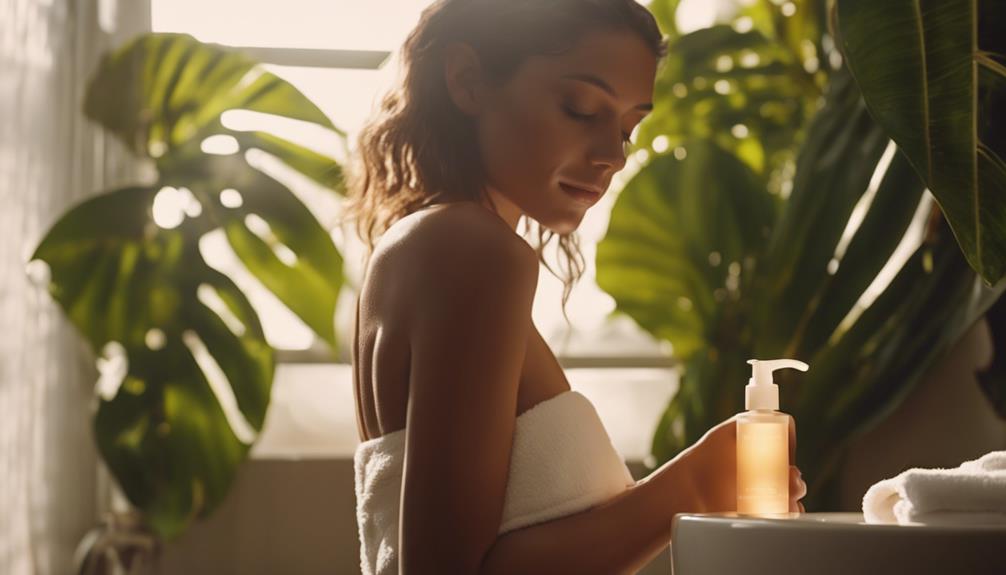
Apply the lotion immediately after tanning or showering to guarantee ideal absorption and effectiveness.
Use a generous amount to cover all areas, ensuring you don't miss spots prone to dryness. Focus on your arms, legs, and back, where skin often needs extra hydration.
Rub the lotion in using circular motions for even distribution, and don't forget to pay attention to your elbows and knees, areas that can become dry.
Allow the lotion to absorb fully before dressing to prevent transfer onto your clothes.
For best results, reapply daily to maintain moisture and prolong your tan.
Store your lotion in a cool, dry place to keep its properties intact.
Following these steps will help you enjoy your tan longer.
Options for Sensitive Skin
For those with sensitive skin, choosing hypoallergenic tan extenders is essential to minimize irritation and guarantee a comfortable tanning experience.
You'll want to look for products that prioritize gentle formulations. Here are some key features to take into account:
- Hypoallergenic Ingredients: Confirm the lotion is free from common allergens.
- Soothing Additives: Look for calming elements like aloe vera and chamomile.
- Non-Comedogenic: Choose options that won't clog your pores.
Fragrance Considerations
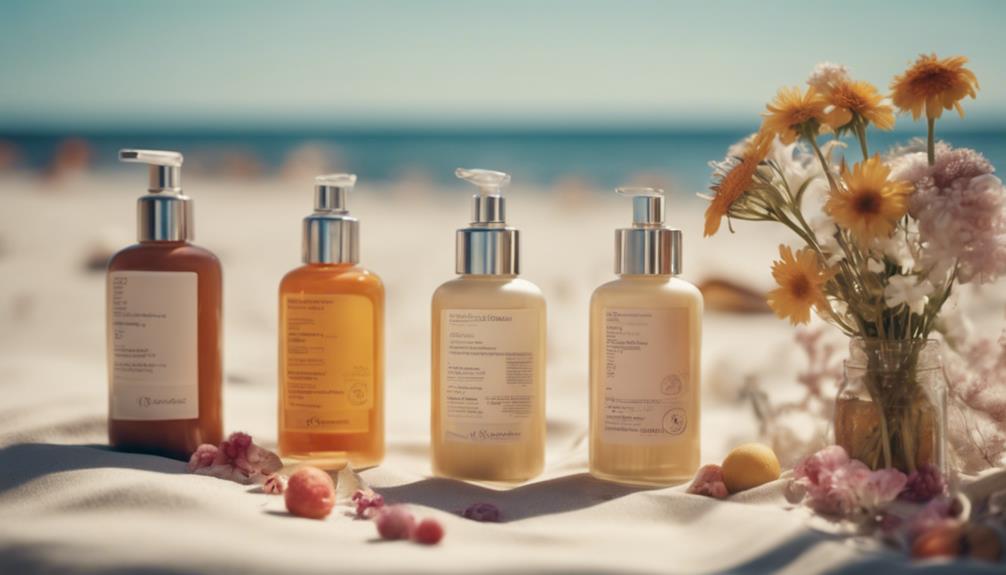
Fragrance plays a significant role in enhancing your tanning experience, so choosing the right scent can make all the difference. You'll find a variety of fragrance options, from delightful tropical scents to light, fresh aromas.
Reflect on your personal preference—do you prefer coconut, pineapple, or something more subtle? Remember that some products may have overpowering scents that could irritate sensitive skin, so it's wise to test before full application.
If you're particularly sensitive, you might want to think about fragrance-free options. Ultimately, the right fragrance not only uplifts your mood but also enhances your overall experience, making your post-tan routine feel like a pampering session.
Choose wisely to enjoy the full benefits of your after-tan lotion!
Moisturizing for Lasting Results
Moisturizing your skin after tanning is essential to prolonging your tan and keeping it vibrant. When you apply a rich, hydrating lotion, you're ensuring that your skin retains its bronzed glow while preventing dryness and peeling.
Here are some key benefits of moisturizing:
- Helps to retain bronzing pigments longer.
- Minimizes the risk of peeling and irritation.
- Maintains an even, vibrant tan.
Choose a lotion packed with natural ingredients like aloe vera and shea butter to maximize these benefits.
Regularly moisturizing not only enhances the appearance of your tan but also supports overall skin health and comfort.
Don't skip this vital step in your post-tan routine!
Popular Product Recommendations
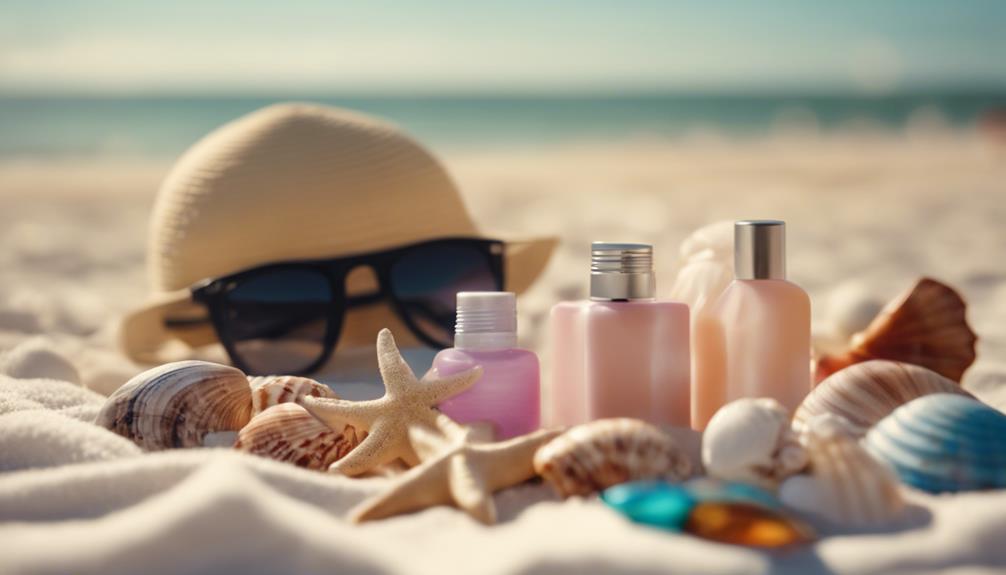
Finding the right after-tan lotion can amplify the benefits of moisturizing, ensuring your skin stays hydrated and your tan remains vibrant.
Consider the Saltwater Beaches Tan Extender for its aloe vera base and vegan formula.
If you prefer quick absorption, Millennium Tanning Solid Black offers essential oils with a light scent.
For a tropical touch, try Hempz Limited Edition Coconut Colada, made with 100% pure hemp seed oil.
The Maui Babe After Browning Lotion is lightweight and rich in natural Hawaiian ingredients, perfect for soothing sun-kissed skin.
Finally, Hawaiian Tropic After Sun Body Butter provides up to 12 hours of hydration with its coconut oil blend.
Each of these options can help maintain your gorgeous glow!
Frequently Asked Questions
How Do I Choose the Right Tan Extender for My Skin Type?
To choose the right tan extender for your skin type, consider your skin's sensitivity, look for hypoallergenic options, and select products with nourishing ingredients like aloe and shea butter. Test a small area first.
Can I Use Tan Extenders on My Face?
Yes, you can use tan extenders on your face, but choose hypoallergenic options specifically formulated for facial skin. Always test a small area to avoid irritation and guarantee it suits your skin type.
Are Tan Extenders Safe for Children?
While it's tempting to treat kids like mini beach bums, tan extenders aren't typically recommended for children. Their skin's delicate nature requires extra caution, so it's best to consult a pediatrician before application.
How Long Will My Tan Last With a Tan Extender?
Your tan can last considerably longer with a tan extender, often up to a week or more. It hydrates your skin and helps maintain an even color, so regular application is key for best results.
Can I Use a Tan Extender With Self-Tanning Products?
Yes, you can use a tan extender with self-tanning products. They work together seamlessly, enhancing your color while moisturizing your skin, ensuring your tan stays vibrant and even, just like a sun-kissed glow after a beach day.
Conclusion
Now that you're equipped with the knowledge to choose your perfect after-tan lotion, you can keep your skin looking vibrant and feeling nourished.
Think of it like putting the finishing touches on a masterpiece; your tan deserves that extra care.
By selecting the right product and applying it effectively, you'll not only extend the life of your glow but also indulge your skin in hydration.
So go ahead, pamper yourself and let your confidence shine through!
